Hamartia Antidote
ELITE MEMBER

- Joined
- Nov 17, 2013
- Messages
- 35,188
- Reaction score
- 30
- Country
- Location
http://www.popularmechanics.com/space/solar-system/a25099/nasa-develops-a-computer-chip-venus/
Humanity has sent four rovers to Mars, and worldwide there are four more missions in the works to continue populating the red planet with robotic explorers. Why haven't we sent a rover to Venus, our other next door planetary neighbor? Because the caustic surface of Venus will incinerate electronics with its 872º F temperatures and seize mechanical components with its immense atmospheric pressures. At 90 times the surface pressure of Earth, the surface of Venus is the equivalent of being almost 3,000 feet underwater.
The Great Galactic Ghoul might devour half the spacecraft we send to Mars, but Venus torched any ghouls living there long ago.
Fortunately, NASA recently took a big step toward achieving the dream of a Venusian rover. As reported by Ars Technica, researchers at the NASA Glenn Research Center built a computer chip that survived Venus-like conditions for an impressive 521 hours, almost 22 days. Even then, the experiment had to end not because the chip was breaking down, but because the Glenn Extreme Environments Rig (GEER)—the chamber that maintains simulated Venus temperatures and pressures—needed to be shut down after running for over three weeks straight.

A silicone carbine chip glowing red hot in NASA Glenn's GEER at over 750º F (400º C). The SiC transistor gate glows blue.
The spacecraft that holds the record for functioning the longest on the surface of Venus is Venera 13, a Soviet craft that landed back in 1982 and transmitted data about its environment for 127 minutes. For its Venera and followup Vera programs, the USSR housed electronics in hermetically sealed chambers that were sometimes cooled to about 14º F (-10º C) before being dropped into the Venusian atmosphere, and even then, two hours was the best they could do.

Images returned by the Venera 13 lander on Venus.
A conventional silicon chip can stand up to about 480º F (250º C) before the chip's semiconductors stop acting as electrical resistors, rendering the chip useless. In recent years, researchers have been developing compound semiconductors made of silicon carbide (SiC) that can function at much higher voltages and temperatures. Heavy industries and the military make up the majority of the demand for the technology, but NASA has taken notice too. By combining SiC-based transistors with specially developed interconnects—the little wires that connect components on the chip—NASA Glenn successfully built a chip than can stand up to Venus conditions without any external protection.

The SiC chip before and after testing in the GEER chamber.
We still have a long way to go before we can send a rover to Venus, however. As Sebastian Anthony points out for Ars Technica, the Soviets needed to use pyrotechnic charges on Venera 13 and 14 just to operate a drill in the immense Venusian pressures so a sample of soil could be obtained.
Building an entire robotic explorer that could function in such conditions presents virtually endless challenges, but that doesn't mean NASA isn't working on it. One proposal is to send a land-sailing rover that uses a rigid sail of solar cells to power science instruments and propel the craft. The Venusian land-sail hasn't received funding, but optimistically, such a mission could be launched in the 2020s.
It's a lofty goal, but now that we are figuring out how to build electronics that can function in virtual hellscapes, it might not be all that long before we drive a rover around a second alien world.
Humanity has sent four rovers to Mars, and worldwide there are four more missions in the works to continue populating the red planet with robotic explorers. Why haven't we sent a rover to Venus, our other next door planetary neighbor? Because the caustic surface of Venus will incinerate electronics with its 872º F temperatures and seize mechanical components with its immense atmospheric pressures. At 90 times the surface pressure of Earth, the surface of Venus is the equivalent of being almost 3,000 feet underwater.
The Great Galactic Ghoul might devour half the spacecraft we send to Mars, but Venus torched any ghouls living there long ago.
Fortunately, NASA recently took a big step toward achieving the dream of a Venusian rover. As reported by Ars Technica, researchers at the NASA Glenn Research Center built a computer chip that survived Venus-like conditions for an impressive 521 hours, almost 22 days. Even then, the experiment had to end not because the chip was breaking down, but because the Glenn Extreme Environments Rig (GEER)—the chamber that maintains simulated Venus temperatures and pressures—needed to be shut down after running for over three weeks straight.

A silicone carbine chip glowing red hot in NASA Glenn's GEER at over 750º F (400º C). The SiC transistor gate glows blue.
The spacecraft that holds the record for functioning the longest on the surface of Venus is Venera 13, a Soviet craft that landed back in 1982 and transmitted data about its environment for 127 minutes. For its Venera and followup Vera programs, the USSR housed electronics in hermetically sealed chambers that were sometimes cooled to about 14º F (-10º C) before being dropped into the Venusian atmosphere, and even then, two hours was the best they could do.

Images returned by the Venera 13 lander on Venus.
A conventional silicon chip can stand up to about 480º F (250º C) before the chip's semiconductors stop acting as electrical resistors, rendering the chip useless. In recent years, researchers have been developing compound semiconductors made of silicon carbide (SiC) that can function at much higher voltages and temperatures. Heavy industries and the military make up the majority of the demand for the technology, but NASA has taken notice too. By combining SiC-based transistors with specially developed interconnects—the little wires that connect components on the chip—NASA Glenn successfully built a chip than can stand up to Venus conditions without any external protection.

The SiC chip before and after testing in the GEER chamber.
We still have a long way to go before we can send a rover to Venus, however. As Sebastian Anthony points out for Ars Technica, the Soviets needed to use pyrotechnic charges on Venera 13 and 14 just to operate a drill in the immense Venusian pressures so a sample of soil could be obtained.
Building an entire robotic explorer that could function in such conditions presents virtually endless challenges, but that doesn't mean NASA isn't working on it. One proposal is to send a land-sailing rover that uses a rigid sail of solar cells to power science instruments and propel the craft. The Venusian land-sail hasn't received funding, but optimistically, such a mission could be launched in the 2020s.
It's a lofty goal, but now that we are figuring out how to build electronics that can function in virtual hellscapes, it might not be all that long before we drive a rover around a second alien world.


